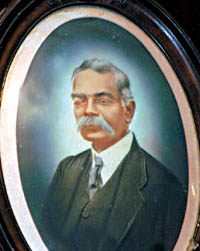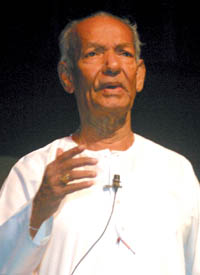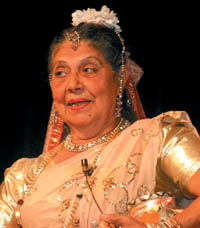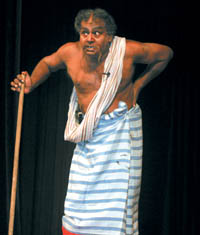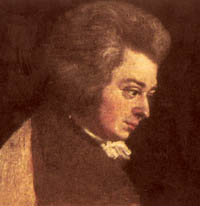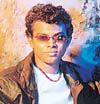|
DAILY NEWS ONLINE |
|
|
|
OTHER EDITIONS |
|
|
|
|
|
|
|
|
|
OTHER LINKS |
|
|
|
|
|
|
  |
|
|
|
|
The 149th birth anniversary of John de Silva, playwright and play-producer, a pioneer in the field of Sinhala drama was held recently. His death anniversary fell on January 28. He passed away 84 years ago in 1922.
'Danno Budunge' is one of our best known songs. Sung over and over again by four or five generations, it has a sentimental appeal that is quite out of its context. I remember, the SLBC once played it as the signature tune when announcing election results.
Many may not know all the words of the song, but they will recognize the tune at once. However, I was surprised to find that students studying 'Sangeetha' as a subject for the O/Level, didn't know that it was from John de Silva's play Sirisangabo. This sung by the three princes Sangha Tissa, Sangha Bodhi (Sango Bo) and Gotabhaya as they approach Anuradhapura and see the dagobas in the distant horizon.
|
|
The John de Silva hall behind the Art Gallery in Colombo was built in 1974 in honour of and to commemorate this great playwright and play-producer who made theatre-going the most popular form of entertainment in the early decades of the 20th century. The epithet, 'Proctor of the Supreme Court' is added after his name in printed text of his plays. He was a playwright and play-producer long before he passed out as a lawyer.
Born in Kotte on January 13, 1857 to Catholic parents, he was sent first to Christian College, Kotte and then to the Colombo Academy which later became Royal College, and at age 20 he was a teacher at St. Joseph's College and later at Wesley College. As he moved closely with oriental scholars like Pundit Batuwantudawa he had acquired a good command of the Sinhala language too.
Like many young men of his age living close to Colombo, John de Silva too must have been a theatre fan, who tried his hand at play-writing and producing. The first play he wrote was Nalaraja, which was staged in 1888, when he was only 29. This was followed by Dascon, the story of the Portuguese General who had a love affair with the Sinhala Princess Samudra Devi.
|
|
His next play 'Ramayanaya' was staged on May 31, 1889 (according to some writers in 1888) at the Floral Hall in Pettah, a popular venue for plays.
On the night of the second performance, June 5, the hall caught fire, and stage sets, curtains, costumes etc. were destroyed. It was believed to be arson by those jealous of his success.
First shock and then grief turned into anger and he gave vent to his anger in a booklet he published in Sinhala titled 'Fire-fight or Hanuman comes to Floral Hall.' It was Hanuman the monkey who set fire to the garden where Sita was kept a prisoner by Ravana. Later in the year he printed and published the play with the title 'Sitaharanaya' (abduction of Sita) or 'Ginigath Ramayanaya' (Ramayanaya that caught fire).
Downcast and disgusted, he gave up writing and producing plays and entering Law College qualified as a proctor, and started practising as a lawyer. This was in the 1890s, and the beginning of the 29th century.
|
|
Once again he was drawn to the theatre and with the writing and producing of Siri Sangabo began the second and the best phase of his career as playwright and producer. First staged in 1903, Siri Sangabo is perhaps his most popular play and a perennial favourite. After Siri Sangabo, his group of actors - there were no actresses then - became professionals, known by the name Arya Suboda Natya Saba. They entertained audiences every night, and there were the regular theatre-goers who didn't miss a John de Silva play.
By this time he had become a Buddhist and also a devotee of the Hindu Gods. It is on record in his own writing, says Sunil Ariyaratna who has made an indepth study of John de Silva's plays, "that after the first premier of Ehelepola, he made offerings to God Kataragama and God Vishnu".
John de Silva wrote plays not only to entertain the public. Through his plays he tried to inspire in the audience a feeling of nationalism, a sense of pride in our culture and heritage and encourage them to regain the lost freedom. He poked fun at those who slavishly aped the white ruling class and he was averse to alcohol. It is on record that he didn't engage any actors who had taken to drinking. In his own small way he was contributing to the national movement, and he was among the Sinhala leaders arrested and jailed after the riots of 1915.
|
|
The Tower Hall and John de Silva's Nrtti have become synonymous when we speak of Tower Hall plays, we mean Nrtti and Nrtti are J de S's plays.
But it was many years later the Tower Hall was built and opened for public performances that a play by John de Silva was staged there. Folk lore says that the proprietor of Tower Hall, G. Don Hendrik Seneviratne, whose son-in-law Charles Dias was J. de S's rival in the theatre, did not permit J. de S's plays staged there.
Only Charles Dias' plays were staged at the Tower for a number of years, and they were so popular that many actors left John de Silva's Arya Suboda Natya Sabah and joined Charles Dias' Arya Sinhala Natya Sabah.
John de Silva's last play was Nagananda written in 1919 and staged at the Tower Hall. He passed away on January 28, 1922 after a brief illness.
He was 65 years old. He had injured his foot while swimming in the sea, and being a diabetic the wound had proved fatal.
- Sumana Saparamadu
A program to felicitate the works of John de Silva was held at the
Tower Hall organised by the Tower Hall Foundation on January 25. The
audience was able to see a host of artistes bring back to life a by-gone
era on stage.
Pix. by Sudath Nishantha
############
Commemorating the 250th birth anniversary of Mozart
|
|
An anniversary of a great event is a time for reflection, commemoration and prayer. The 250th birth anniversary of the great German - Austrian composer Wolfgang Amadeus Mozart, which fell on January 27 , is indeed such an occasion. Mozart is one of the viennese Classics (Wiener Klassik) - Joseph Haydn, Mozart and Ludwig van Betthoven - the three great composers who epitomized the classical epoch of western music. More importantly, he is one of the three supreme masters of all time - Johann Sebastian Bach, Mozart and Beethoven. His noble creations continue to enrich the lives and uplift the spirit of millions of music-lovers ever since the time they were composed. Mozart's sparkling music is fresh and invigorating as ever. It is immortal and timeless. Time has failed to leave its mark on his music.
Career
Wolfgang Amadeus Mozart was born on January 27, 1756 in Salzburg, Austria. He was the son of Leopold Mozart, a notable German musician who was the vice-Kapellmeister to the ruling prince- archbishop of Salzburg. Mozart, who was extraordinarily gifted, had a dazzling musical career as a child prodigy. He performed the piano throughout Europe and started composing at a tender age of five. His father, Leopold Mozart, was his teacher, mentor and business promoter. At the age of thirteen he joined the services of the ruling archbishop of Salzburg as a concert master. However, his relations with employer, which was never a happy one, came to an abrupt end in 1781. Mozart, who requested permission to resign, was literarily kicked-out from the presence of his employer, Count Hieronymus Colloredo, Prince-Archbishop of Salzburg. From there onwards, Mozart earned his living as a free-lance musician. He married the singer Constanze Weber, and settled down in Vienna, where he died on December 5, 1791 at the early age of 35. He was plagued with poverty and poor health during the last stages of his life. He was buried in a pauper's grave. The exact whereabouts of his grave remains unknown.
Music
Mozart enriched all the major forms and types of compositions of the classical era - symphony, concerto, string quartet, solo sonata, opera etc. He wrote more than 40 symphonies, of which the Prague and the last three symphonies are the greatest. He reached the zenith of his symphonic creations in his last symphony, the Jupiter. The last movement of the Jupiter symphony - the so-called fugal finale, is a grand synthesis of sheer classical beauty and irresistible energy - a tour de force accomplished with an outstanding mastery of the art of counterpoint!
Mozart was a supreme master in the field of concerto writing. He composed around thirty concertos for piano and orchestra, which include the Coronation Concerto (K 537). He penned yet another twenty odd concertos for other combinations of solo instruments (such as violin, flute, clarinet, horn, harp etc.) and orchestra, which include five violin concertos. He also wrote more than a hundred chamber music compositions, which include twenty six string quartets and the charming clarinet quintet in A major (K 581). Mozart penned around eighty works for solo piano, which include eighteen piano sonatas. The well-known Alla Turca, with its subtle humour, is the final movement of his much-played piano sonata in A major (K 331). The delightful Eine klene Nachtmusik (K 525) is one of the forty odd Serenades and Divertimenti he composed for various combinations of instruments.
Mozart's supreme achievements are not restricted to the field of instrumental music. He excelled in the realm of vocal music as well. He is one of the world's greatest composers of opera. The Marriage of Figaro, Don Giovanni and The Magic Flute are three of his great operas. The Magic Flute is in fact one of Mozart's supreme creations. Mozart composed several masses, of which the celebrated Requiem in D minor is the most famous. The Requiem, which was his last composition, was incomplete at the time of his demise. The work was completed by his pupil F. X. Suessmayr.
Legacy
Mozart's music, more than that of any other composer, epitomizes the ideals of classicism and the Enlightenment - reason, elegance, balance and restraint. Together with Joseph Haydn, who was 24 years elder to him, he brought the classical Sonata - Symphony Form and Style to its perfection. He was one of the world's greatest melodists and also a great master of harmony.
His creations are infused with an abundance of joy, tenderness, pathos and humour and are always full of life. Robert Schumann described his music as Brilliance, tranquillity and Grace (Heiterkeit, Ruhe und Grazie). Richard Wagner described him as the greatest and the most divine genius. His immortal music, like all truly great music, is a priceless spiritual treasure of mankind.
#########
The Jothipala syndrome
At one time singer H. R. Jothipala made a change from mundane to a popular note, later a lot of others followed. But the difference is that all those others were not able to stand the test of time and as of today Jothipala is bridging a gap. That's an unconscious fact.
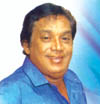 |
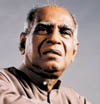 |
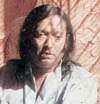 |
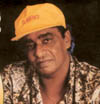 |
 |
 |
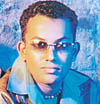 |
|
|
Once H. R. Jothipala was considered just another popular voice in comparison to other singers and their music, which spelt local by all means; which was looming in the local music industry during the 60's and 70's. Today the sense of spirit in his songs are bridging the gap between an era that is common place and slipping out while a whole new generation of singers are arriving with gusto. Are the older guard of singers, song writers and composers willing to listen?
Our music and song has always been based mostly on words (lyrics). Even though rhythm and pace did have a part to play it has played the same role in our music for over two decades. The new generation of singers here are basing their creations by bringing in to play those two important components in today's popular music, not only here in Sri Lanka but the world over.
But most composers and song writers have not used this growing trend in our favour by creating rhythms that consist of our folklore and indigenous music methods that we are proud bearers of.
In a recent television interview a leading singer from the days gone-by commented that he is glad that song writers have come up with compositions for his new collection which is to be released as a CD. "Listening to what is passing off as music today surprises me", said the singer. But a bigger surprise was in store later in the programme for viewers when the presenter of the programme requested the singer to voice a few lines from the new collection.
His voice has lost its tone and he was almost struggling through the notes. The so-called NEW song written by a well-known lyricist sounded same as many other songs voiced by this singer.
Now are these the so-called maestros that sit up and criticise the younger generation? This is not the first time that singers both male and female from the by-gone era have faltered in public. Their refusal to accept that everything fades with time and their attitude that nothing can match up to the kind of music they produced during their time is showing them under dim light.
Even song writers prefer to languish in past glory of these artists than try composing for the present generation of singers, specially the ones that are harbouring in to different areas such as rap or fusion music. Though it must be admitted that most of these younger musicians have not been able to grasp a method of adapting those western developments to suit the goings-on in our music industry.
Today we are at the crossroads in trying to identify and label our music because they come in different flavours and with a barrage of sounds invading us from all parts of the world. Owing to the wide communication possibilities that are available today it is only natural that younger people will explore.
If we look back to the earliest stages of our music one would realise that we were totally dependent on South India. Not only the melodies were copied even lyrics were used with words that rhymed along with its original song, leaving behind whatever meaning those words were to convey.
At the beginning it was not only music and song but even the singers came from Southern India. Jamuna Rani, Jikki, A. M. Raja, Gandasala etc. With G. Ramanathan, T. R. Papa and the like having a large slice of the background musicians cake to themselves.
As film makers B. A. W. Jayamanne, K. Gunaratnam, S. P. Muththiah and others made way for directors Sarath Wimalaweera, Robin Tampoe and others in to the local film industry musicians such as R. Muththusaami, Roksaami and the like along with H. R. Jothipala, J. A. Milton Perera and Mohideen Baig began having full command over the film industry which ran parallel with whatever that was developing both in North and South India. In the meanwhile another line of thinking was evolving on the sidelines.
With films such as Sandeshaya and Gamperaliya and others that followed coming in to focus creating a wider local image both here and abroad, musicians such as Somadasa Elvitigala, Khemadasa and W. D. Amaradeva were responsible in developing and writing music with a more traditional flavour which also had an immediate audience to grow with. With all the change that was creeping up H. R. Jothipala managed to exalt his position in the more popular bracket. His duets with all the top female singers like Latha Walpola, G. S. B. Rani Perera and later with Sujatha Attanayake and Angeline Gunatileke were heard through the radio almost on a regular basis.
There was not many noticeable changes in this pattern until the early seventies when the harmonising trends again from the west hit our shores.
La Ceylonians, The Dharmaratne Brothers, Los Caballeros were some of the earlier harmonising groups to invade younger audiences. C.T. Fernando who was an established singer at that time actually came in to the more popular enclave of things by appearing on stage along side these groups. That stream of music took a higher level with Clarence Wijewardena along with his Moonstones coming into the limelight riding a similar wave and Indrani Perera became a sensational discovery during this period.
Rookantha Gunatileke at one point became an idol amongst the young for his new approach and the ability to change the pace to suit the aspirations of his young fans. His music was unique in terms of what's happening at present with certain individual singers as well as musical groups today.
Commenting on western influences in our music scene critics referred to it as 'Thuppahi Sanskruthiya' which is a general term used at society adapting to all kinds of western trends. So it was natural that musical groups, baila singers and other singers who swayed towards unusual high tempo music was picked on.
As Sri Lanka opened up as a free economy in 1977 more influences (the bad ones) from neighbouring India and the west began to creep up. This began to infiltrate and model our culture in an uncontrollable fashion. The trend has continued un-checked and un-abated to date. Besides an increase in numerous borrowed influences singers are copying melodies of foreign composers and setting it against 'badly written' lyrics.
A minute fraction amongst the new wave of singers are trying their best to produce something meaningful.
Bathiya and Santush can be scaled as pioneers and at the same time victims of this exercise as they have undergone heavy undue criticism for whatever they were trying to achieve.
It is time for us to review the situation, instead of pointing a finger at the younger set, who are eager to try out new methods.
It is a waste to put aside whatever these young musicians are producing as trash; instead of such arrogant moves veterans in the industry should try to tie-up with them (remember Visharada Nanda Malini's debut on such an exercise with the musical group Siha Shakthi quite sometime ago).
There are wonderful opportunities awaiting to be explored which are sadly lying un-tapped. Unless this cohabitation takes place the legendary H. R. Jothipala (to my sincere delight) will continue to bridge the gap between a meaningful generation of singers who are slipping in to oblivion against meaningless trends that are emerging in full force and gusto, bringing with it the downfall of an industry that was built upon the sweat and toil of dedicated artists.
|
|

